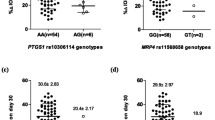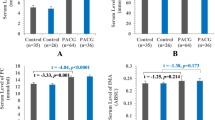Abstract
The oxidation of debrisoquine, a sympatholytic antihypertensive agent, exhibits genetic polymorphism. The debrisoquine/4-OH-debrisoquine metabolic ratio (MR) separates the population to poor (PM, MR>12.6) and extensive (EM, MR<12.6) metabolizers. 5–10% of the caucasians belong to the PM phenotype. The oxidation of many other drugs, like timolol, correlates with the debrisoquine phenotype.
We determined the debrisoquine phenotype in 102 glaucoma patients. The majority of the patients was treated with ophthalmic timolol. Five patients were classified as PMs. However, two of them were on quinidine, a well known inhibitor of debrisoquine oxidation.
The prevalence of debrisoquine PM phenotype in glaucoma patients was 2.9% (excluding patients on quinidine) or 4.9% (with patients on quinidine). The figures are slightly lower than the mean value reported for the normal Finnish population. However, both figures lay within the 95% confidence limits of the prevalence of PM phenotype in the normal Finnish population. The beta-blocking activity of oral timolol is increased in PMs. The significance of timolol oxidation phenotype during ocular timolol therapy warrants further investigation.
Similar content being viewed by others
References
Alvan G, von Bahr C, Seideman P, Sjöqvist F. High plasma concentrations of β-receptor blocking drugs and deficient debrisoquine hydroxylation. Lancet 1: 333, 1982
Bergamini MVW. The metabolic mechanisms affecting drug actions in the eye. In Drace SM, Neufeld AH (eds) Glaucoma: Applied pharmacology in medical treatment. Grune & Stratton, Inc. Toronto pp 151–184, 1984
Eichelbaum M. Polymorphic drug oxidation in humans. Fed Proc 43: 2298–2302, 1984
Evans DAP. Genetic studies involving drug metabolism in man. In: Gorrod JW, Beckett AH (eds) Drug Metabolism in Man. Taylor and Francis, London pp 135–155, 1978
Evans DAP, Mahgoub A, Sloan TP, Idle JR, Smith RL. A family and population study of genetic polymorphism of debrisoquine oxidation in a white British population. J Med Genet 17: 102–105, 1980
Kaila T, Salminen L, Huupponen R. Systemic absorption of topically applied ocular timolol. J Ocul Pharm 1: 79–83, 1985
Kaila T, Huupponen R, Salminen L. Effects of cyelid closure and nasolacrimal duct occlusion on the systemic absorption of ocular timolol in human subjects. J Ocul Pharm 2: 365–369, 1986
Kallio J, Lindberg R, Huupponen R, Iisalo E. Debrisoquine oxidation in a Finnish population: the effect of oral contraseptives on the metabolic ration. Submitted for publication 1988
Lennard MS. Oxidation phenotype and the metabolism and action of beta-blockers. Klin Wochenschr 63: 285–292, 1985
Lennard MS, Silas JH, Smith AJ, Tucker GT. Determination of debrisoquine and its 4-hydroxy metabolite in biological fluids by gas chromatography with flame-ionization and nitrogen-selective detection. J Chromatogr 133: 161–166, 1977
Lennard MS, Tucker GT, Woods HF. The polymorphic oxidation of β-adrenoceptor antagonists. Clinical pharmacokinetic considerations. Clin Pramacokin 11: 1–17, 1986
Lewis RV, Lennard MS, Jackson PR, Tucker GT, Ramsay LE, Woods HF. Timolol and atenolol: relationships between oxidation phenotype, pharmacokinetics and pharmacodynamics. Br J Pharmac 19: 329–333, 1985
McGourty JC, Silas JH, Fleming JJ, McBurney A, Ward JW. Pharmacokinetics and beta-blocking effects of timolol in poor and extensive metabolizers of debrisoquin. Clin Pharmacol Ther 38: 409–413, 1985
Shichi H, Biotransformation and drug metabolism. In Sears LM (ed) Pharmacology of the eye. Springer-Verlag, Berlin pp 117–148, 1984
Speirs CJ, Murray S, Boobis AR, Seddon CE, Davies DS. Quinidine and the identification of drugs whose elimination is impaired in subjects classified as poor metabolizers of debrisoquine. Br J Clin Pharmacol 22: 739–743, 1986
Syvälahti EK, Lindberg R, Kallio J, De Vocht M. Inhibitory effects of neuroleptics on debrisoquine oxidation in man. Br J Clin Pharmacol 22: 89–92, 1986
Tocco DJ, Duncan AEW, Deluna FA, Hucker HB, Gruber VF, Vandenheuvel WJA. Physiological disposition and metabolism of timolol in man and laboratory animals. Drug Metab Dipos 3: 361–370, 1975
Tucker GT, Silas JH, Iyun AO, Lennerd MS, Smith AJ. Polymorphic hydroxylation of debrisoquine. Lancet 2: 718, 1977
Van Buskirk EM, Fraunfelder FT. Ocular beta blockers and systemic effects. Am J Ophthalmol 98: 623–624, 1984
Author information
Authors and Affiliations
Rights and permissions
About this article
Cite this article
Salminen, L., Lindberg, R., Toivari, H.R. et al. Prevalence of debrisoquine oxidation phenotypes in glaucoma patients. Int Ophthalmol 13, 91–93 (1989). https://doi.org/10.1007/BF02028645
Issue Date:
DOI: https://doi.org/10.1007/BF02028645




